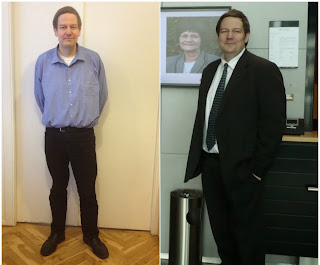Now, here's a man who reaches for the stars
Keith Edwards is my collegue at Nordic Laboratories.
Six months ago, we started a weight loss project, and today - six months after, he almost lost 30 kg... I actually now call him "skinny bitch"!
Six months ago, we started a weight loss project, and today - six months after, he almost lost 30 kg... I actually now call him "skinny bitch"!
Keith would like to share with you the most important things he has learned from this process. Hence, he has written 12 bullet points which in his point of view have been the most important areas in order to lose weight, maintain this weight and keep a healthy lifestyle.
For those of you, who would like to read more about the process from my point of view, you're welcome to check it out here (in Danish).
For those of you, who would like to read more about the process from my point of view, you're welcome to check it out here (in Danish).
Keith, the stage is yours....
6 months have now gone by since I started with my
project to lose weight, and get healthier & fitter. As it is now also a new
year and I have had a bunch of people ask me “How did you do it? Do you have
any tips for me?”, I have decided to put something together to answer those
questions. If you want more specific information about any of the points below,
just let me know.
Twelve tips I have learned from my efforts to lose weight and get fit:
1: Processed food
The more food is processed before you eat it, the harder it is for the
body to break it down and get the nutrients out of it. Whenever possible go
“organic” as that kind of food isn’t processed “to death”.
2: Milk (and other food and drinks containing lactose)
Once you are fully-grown your body simply doesn’t need lactose as much as
before.
3: Starch
While starch will help you to stop feeling
hungry, it doesn’t really offer your body anything like nutrients. Only eat
sparingly. This is most visible with plain products like white rice, regular
pasta, potatoes & white and brown bread. Products like wholegrain rice
& pasta, ryebread & sweet potatoes contain more nutrients and fiber and
are therefore better for you, although it is wise to limit the amount you eat
anyway.
4: “Diet” products
Typically they reduce fat in a
product and often they replace it with sugar to add flavor. So be careful when
buying “diet” products and check what they include.
5: Sugar
Your body prioritises burning sugar over
burning fat, so when you eat sugar, your body simply stores the fat instead of
burning it.
6: (Cooking) oils
When heating oil, such as when
frying, it changes the structure of the oil, making it harder for the body to
break it down. Normally “good” oils, like Olive Oil, turn “bad” for the body.
Only Coconut oil remains “good” under heating. If you are looking for a
slightly cheaper and easily obtainable oil, then go for Rapeseed oil, which has
a higher tolerance for heat without changing its structure.
7: 50/25/25 split
When you are eating meals, use the
50/25/25 split on your plate. 50% vegetables, 25% starch (potatoes, rice or
pasta), 25% meat.
8: Plan ahead
The hardest moments to stay on track are typically when you are hungry, or when
there are temptations nearby that require little effort rather than having to
do something to keep on track. So I found it easier to plan ahead. This means
knowing what is happening regarding dinner long before I am hungry, or making
sure I have healthier snacks lying around (fruit, ryebread with organic peanut
butter, canned tuna, certain vegetables (like red peppers))
9: Commitment
Doing something like this, which
requires a fairly drastic lifestyle change, is not easy. Temptations are
everywhere and it is very easy to fall back on the things you already know and
like (even if they are not good for you). Because of this I personally don’t
try to overdo it. The occasional small “slip” is better than giving up. So
reward yourself occasionally with a treat. Make sure it is not too often tho.
10: Levels of activity
Little things like walking or
biking instead of taking the bus, or walking up stairs instead of taking the
elevator all help. Try and find little ways of doing this.
11: Fitness
Doing fitness 2-3 times a week helps
reduce fat and build muscles. This doesn’t necessarily need to be at a fitness
centre, it can be doing a sport, going swimming, etc…
12: Genetics
We are all set up slightly differently
and getting to know how your body is set up (and how it reacts to various
things) is key to helping you get healthier. This point can not be stressed
enough, as a slightly different genetic build-up can have a big difference in
how your body reacts to all the previous points. Our genes tell us where our
individual challenges lie and therefore where you should focus your efforts
(diet, fitness, etc…) as well as tell you how quickly your body will adapt to
this new situation.
And here's some pictures of Keith before and after (The picture at the left, being "the after picture", of course ;))



Ingen kommentarer:
Send en kommentar